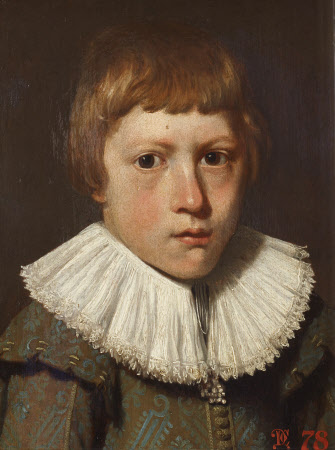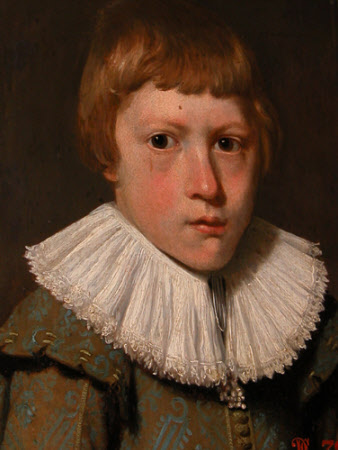Called Henry Cromwell (1628-1674)
attributed to George Jamesone (Aberdeen c.1588 – Edinburgh c.1644)
Category
Art / Oil paintings
Date
circa 1635
Materials
Oil on panel
Measurements
323 x 246 mm
Place of origin
Great Britain
Order this imageCollection
Anglesey Abbey, Cambridgeshire
NT 515494
Summary
Oil painting on panel, Called Henry Cromwell (1628-1674), attributed to George Jamesone (Aberdeen c.1588 – Edinburgh c.1644). A head-and-shoulders portrait of a boy with white linen falling ruff edged with lace and wearing a green and blue embroidered doublet. Monogram DC 78 in bottom right corner (DC stands for Domville, one time owner of portrait). Label on frame 'Henry Cromwell, 1628-1674, 4th son of Oliver Cromwell. Geoge Jameson 1586-1644. From the Collection of Sir C. Domville, Bart, Santry Court, Dublin'. Henry was the 4th son of Protector. Born Huntingdon 20 January 1628, entered parliamentary army towards end of 1st civil war. In summer of 1648 appears to have been serving under father in north of England. In Feb 1650 attained rank of colonel, and followed father to Ireland with reinforcements. In 1653 nominated one of representatives of Ireland in Barebones Parliament. On establishment of protectorate, father despatched him to Ireland to discover feelings of Irish officers towards new government and to counteract influence of anabaptists. In Aug 1654 new Irish council was commenced and Council of State voted Henry Cromwell should be appointed commander of Irish army and member of new council. 25 December 1654 became member of Irish Council and 24 August 1654 became Major-General of forces in Ireland. Fleetwood, though staunch supporter of Protectorate, too deeply involved with anabaptists, therefore recalled but still retained title of lord-lieutenant, so that Henry Cromwell was merely his deputy. After second foundation of protectorate, Henry Cromwell at length appointed lord-lieutenant by commission dated 16 November, 1657. Popularity shown by vote of Parliament on 8 June 1657, settling on him lands to value of £1,500 a year, which he refused on grounds of poverty of Ireland and indebtedness of England. Also charged to disband large part of army but not allowed to have voice in management of disbanding. Wrote that £196,000 needed for Ireland: only got promise of £30,000. To have succeeded under such unfavourable circumstances in maintaining tranquility, was no small proof of Henry Cromwell’s ability as ruler. His adversaries were leaders of military party surrounding Protector, desirous of perpetuating own arbitrary power. Both directly and through Thurloe, urged father to refuse title of King, but to endeavour to obtain new constitutional settlement offered him by Parliament. Great aim was to found protectorate on as broad a basis as possible, to free it from control of military leaders, and to rally to its support as many of royalists and old parliamentarians as possible. On father’s death, received new commission as lieutenant and governor-general. With reluctance accepted offer, had preferred to return to England to confer with brother Richard and friends on principles of Irish policy and plans of new government in England. Soon after told of fall of brother’s government; prepared to act for his brother’s restoration if commanded. During this period, the hopes of the royalists was high, and Charles II made overtures to Henry Cromwell 7 June ordered to deliver up governership of Ireland and return to England, giving account of his conduct to council of state. For remainder of life lived in obscurity. Charles II seems to have been satisfied of his peaceable intentions. Died on 23 Mar 1674 aged 47, buried in Wicken church.
Provenance
Sir Compton Domville, 2nd Bt (1696-1768), Santry Court, Dublin; bequeathed to the National Trust by Huttleston Rogers Broughton, 1st Lord Fairhaven (1896-1966) with the house and the rest of the contents.
Credit line
Anglesey Abbey, The Fairhaven Collection (National Trust)
Marks and inscriptions
DC 78
Makers and roles
attributed to George Jamesone (Aberdeen c.1588 – Edinburgh c.1644), publisher


